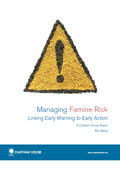The recovery in the United States has remained sluggish because there are too many anchors weighing it down. The continued weakness in the housing market has kept residential construction at depression levels. Historically, U.S. recoveries have always featured a lift from housing, this has not happened in this recovery and it may be another couple of years before all of the foreclosures are worked through. The good news is that residential construction has stopped falling, but housing prices are still declining slowly on average. The housing problems are not spread evenly around the country but rather are concentrated in five states, California, Nevada, New Mexico, Florida and Michigan. This raises the hope that there may be a gradual pickup in housing prices and home construction in other regions even though the excess supply of housing still persists in these five states. Policy efforts to mitigate the ongoing tide of foreclosures have had only a very modest impact and it seems that only time will heal this wound.
One endogenous response to the housing crisis has been that fewer new households have been formed as people choose to live with parents or share housing with others. Another response has been a sharp increase in the demand for rental housing, which has in turn triggered construction of multifamily units. The housing recovery will be skewed to multifamily, which is better than nothing but such units have a much lower cost per unit than single family houses and hence contribute less to overall demand.
The weakness in the housing market has contributed to the loss of household wealth. The stock market has recovered much of the huge drop it took in the financial crisis as corporate profits have been strong, but the volatility of markets has made it hard for consumers to take a lot of comfort from the partial recovery of financial wealth. The consumer de-leveraging process continues as debt levels are reduced and borrowing remains subdued. Much of the reduction in household debt so far has come about through defaults and foreclosures rather than repaying debts.
Beyond housing, the other big anchor weighing down the economy is the weakness in household income that is driven primarily by the weakness in the labor market. In fact over the past several quarters, consumer spending has grown a little faster than disposable income, so the saving rate has declined slightly. Consumers are certainly cautious, but the big reason consumer spending growth is slow is that income growth is slow or negative.
There is a widespread view that businesses in the U.S. are holding back on investment and hiring because they are afraid of the huge budget deficits and their potential to cause a new financial crisis or because they think their taxes will go up a lot. There are additional concerns are around the costs imposed by new health care and financial regulation as well as a fear that some version of cap and trade will be introduced and raise energy costs. Assessments of this viewpoint are divided politically, with liberals like Paul Krugman dismissing the idea and focusing instead on demand weakness. However, there is no question that businesses are holding a lot of cash on their balance sheets, indeed the Federal Reserve reports that the cash share of corporate assets is at its highest level since 1959. My own judgment is that by far the biggest reason for weak hiring is the lack of strong demand growth. But rather than seeing this issue as either-or, it is better to view the two views as reinforcing each other. Companies are hesitant to invest and hire mostly for demand reasons, reinforced by regulation and deficit concerns.
It is noteworthy that business investment is actually picking up quite well for both non residential structures and equipment and software. Hiring is indeed still sluggish, so much of the investment so far seems to be replacement investment (including the replacement cycle for IT equipment) or cost-saving rather than for expansion. And the level of business investment is still lower than it was prior to the recession.
The other pieces that go into aggregate demand include government purchases, net exports, and inventories. Of these three, government purchases are declining now because of cutbacks by states and localities, and this decline in government demand may well continue into the future as federal purchases are cut back also, given the strong emphasis in Washington on cutting the deficit. Clearly there is a need for fiscal restraint here but if federal spending is cut quickly, this will have a short term negative impact on demand, something that is being demonstrated in the European setting. Net exports have been helping the U.S. economy for a couple of quarter or so as exports rise faster than imports but the overall impact is small and will likely dissipate in a weakening global economy. Inventories are pretty much impossible to forecast and often have a big impact on the GDP for a given quarter. As long as U.S. production continues at a reasonable pace, inventory accumulation will help that growth, but if growth were to weaken an inventory cycle could easily be the catalyst for a double dip.
Despite these problems, the mood on the economy has improved in the past couple of months with many forecasters starting to revise up their forecasts instead of constantly revising them down. This is not true everywhere–the Federal Reserve and OECD cut their 2012 U.S. forecasts, but these institutions are catching up to the bad economic data in the first half of this year more than responding to the improvement in recent months. Few are expecting really strong growth any time soon, but the chances of a double dip have diminished. GDP growth averaging 2 to 3 percent for the next few quarters seems quite likely and growth in excess of 3 percent is possible in 2012. (Strong export numbers and inventory accumulation could push growth in the fourth quarter above 3 percent).
There are risks to this forecast, of course, with Europe being the main one, but first I will mention two other risks, political deadlock and oil prices. Coming out of the debt ceiling agreement, the special Joint Congressional (Super) committee was charged with finding $1.5 trillion or more of budget cuts (over the 10 year budget window) and they were not able to reach an agreement. Democrats insisted on tax increases on upper income households and the Republicans resisted. The provision of the debt ceiling agreement was that in the event of a committee failure, there are automatic federal expenditure cuts of $1.2 trillion triggered in the form of across the board reductions (with some exceptions). The cuts would be equally split between defense and non defense and would exempt Social Security and low-income programs. Medicare cuts would be limited to 2%. On the face of it you might think this would be a popular outcome for Republicans who are pushing for spending cuts, but that is not the case because of the defense cuts, which would come on top of restraints on the military budget already agreed to. (As part of the debt ceiling agreement, Obama already imposed caps on discretionary spending that are worth $750 billion over 10 years ($900 billion including interest saving)).
The across-the-board spending cuts would start in January 2013. These cuts would not be huge in terms of the annual budget, but across the board cuts are not a good solution and they would be a damper on demand. Now that the “Super Committee” has failed there will likely be an effort to modify the automatic cuts in a way that spares the defense budget. The failure of the super committee has actually left Obama with some negotiating power. He has said he would veto any bill that voided the defense cuts but did not represent a broad deficit reduction effort on the grounds that Congress “needs to do its job” in coming up with the full quota of budget cuts (which in practice means agreeing to tax increases on upper income taxpayers). Of course, we may end up with another frustrating and destabilizing cliffhanger like the debt limit and, if so, the resulting uncertainty will harm the recovery.
Concerns about Iran have pushed the price of oil to around $100 a barrel and a new spike in oil prices would pose a substantial risk to the recovery. I do not know how to assess the risks here in terms of Iran. Turmoil in the mid east is bad news for U.S. and global growth.
Turing to Europe: There was agreement at the recent EU leaders meeting to impose much stricter fiscal controls over members, with only Britain saying no. In return, the leaders agreed to beef up the bail-out fund for countries that get into trouble rolling over their debt obligations. Although Merkel and other leaders rejected the idea of a Eurobond that would impose formal joint liability on all countries for the debts of any single country, a larger bail-out fund may effectively achieve the same result. A coordinated approach to the debt problem is attractive because there is enough economic strength in the region as a whole to support the level of region-wide sovereign debt at a favorable rate of interest. As long as they are protected under the umbrella of the stronger economies, the governments of Italy, Spain and other weaker economies should be able to service their own debt payments. Any debt guaranty from Germany and the stronger economies would only have to be activated if economic conditions were to deteriorate going forward. Given the resistance of the electorates of the strong economies to taking on the risk of having to bail out one or more of the weaker economies, however, the euro debt crisis is not over yet.
Moreover, the agreement reached by the EU leaders has its own pitfalls. The strict budget rules will dampen aggregate demand in Europe and make it more likely that the region will end up in a serious recession, a recession that could even worsen budget deficits. Austerity measures are a two-edged sword. And the role of the European Central Bank is not yet clear. The ECB could play an important role in stabilizing the sovereign debt market through its ability to buy sovereign bonds. And it has played this role at times. However, ECB head Mario Draghi has also made it clear that he expects the EU governments to solve the debt problem themselves and not rely on the ECB as a possible lender of last resort to sovereign governments.
The pessimistic outcome in Europe is the case where the big plan fails and individual countries try to muddle through. In that case, there is a significant danger that financial institutions that have sovereign debt on their books will be liquidity constrained because no one wants to lend to them (this is already a problem). Their own governments could be unable to borrow additional funds to keep the institutions from failing. A cascading series of institutional failures would endanger the whole European financial system.
The prospects for the U.S. recovery, therefore, are mixed. There are continuing problems in the housing market and the vicious circle of low income and low consumer spending continues to keep the economy down. There are signs, however, that the recovery is beginning to take hold and the vicious cycle could turn into a more virtuous cycle of rising income, declining unemployment and stronger demand. The intrinsics of the U.S. economy are good enough to suggest a more sustainable recovery is possible, even likely, in 2012. The biggest danger to the recovery is from a serious setback in Europe. The second biggest is from political conflict here at home.









Commentary
Op-edThe U.S. Economy: Is it Finally Recovering?
December 13, 2011